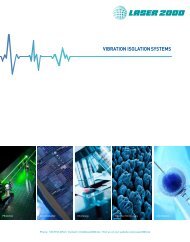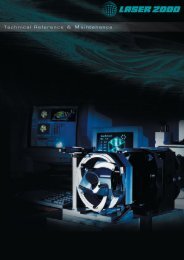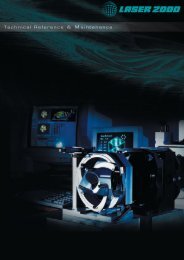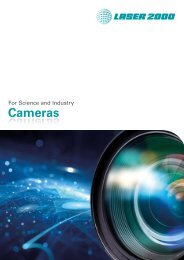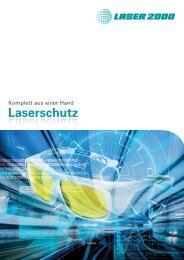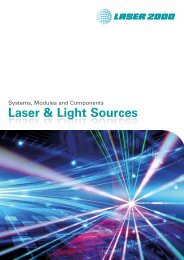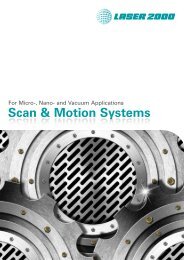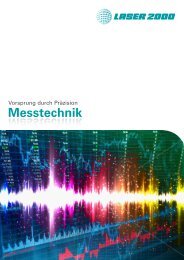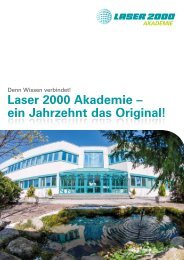Semrock Master Catalog 2018
Semrock Master Catalog 2018
Semrock Master Catalog 2018
Create successful ePaper yourself
Turn your PDF publications into a flip-book with our unique Google optimized e-Paper software.
Fluorophores<br />
Single-band<br />
Sets<br />
BrightLine ® Coherent Raman Scattering (CRS) Filters<br />
TECHNICAL NOTE<br />
Coherent Raman Scattering (CRS, CARS and SRS)<br />
With coherent Raman scattering (CRS) it is possible to perform highly specific, label-free chemical and biological imaging<br />
with orders of magnitude higher sensitivity at video-rate speeds compared with traditional Raman imaging. CRS is a<br />
nonlinear four-wave mixing process that is used to enhance the weak spontaneous Raman signal associated with specific<br />
molecular vibrations. Two different types of CRS that are exploited for chemical and biological imaging are coherent anti-<br />
Stokes Raman scattering (CARS) and stimulated Raman scattering (SRS).<br />
Multiband<br />
Sets<br />
Cubes Laser<br />
Sets<br />
Coherent Raman scattering energy diagrams for both CARS and SRS (left), and a schematic of a typical experimental setup (right).<br />
In CRS, two lasers are used to excite the sample. The wavelength of a first laser (often a fixed-wavelength, 1064 nm laser)<br />
is set at the Stokes frequency, w Stokes<br />
. The wavelength of the second laser is tuned to the pump frequency, w pump<br />
. When the<br />
frequency difference w pump<br />
– w Stokes<br />
between these two lasers matches an intrinsic molecular vibration of frequency Ω both<br />
CARS and SRS signals are generated within the sample.<br />
In CARS, the coherent Raman signal is generated at a new, third wavelength, given by the anti-Stokes frequency<br />
w CARS<br />
= 2w pump<br />
– w Stokes<br />
= w pump<br />
+ Ω. In SRS there is no signal at a wavelength that is different from the laser excitation<br />
wavelengths. Instead, the intensity of the scattered light at the pump wavelength experiences a stimulated Raman loss<br />
(SRL), with the intensity of the scattered light at the Stokes wavelength experiencing a stimulated Raman gain (SRG).<br />
The key advantage of SRS microscopy over CARS microscopy is that it provides background-free chemical imaging with<br />
improved image contrast, both of which are important for biomedical imaging applications where water represents the<br />
predominant source of nonresonant background signal in the sample.<br />
NLO<br />
Filters<br />
Individual<br />
Filters<br />
Dichroic<br />
Beamsplitters<br />
Tunable<br />
Filters<br />
Harmonic Generation Microscopy<br />
CARS Images<br />
Coherent anti-Stokes Raman (CARS)<br />
imaging of cholesteryl palmitate. The<br />
image on the left was obtained using<br />
<strong>Semrock</strong> filter FF01-625/90. The image<br />
on the right was obtained using a<br />
fluorescence bandpass filter having<br />
a center wavelength of 650 nm and<br />
extended blocking. An analysis of the<br />
images revealed that the FF01-625/90<br />
filter provided greater than 2.6 times<br />
CARS signal. Images courtesy of Prof.<br />
Eric Potma (UC Irvine).<br />
Harmonic generation microscopy (HGM) is a label-free imaging technique that uses high-peak power ultrafast lasers to generate<br />
appreciable image contrast in biological imaging applications. Harmonic generation microscopy exploits intrinsic energyconserving<br />
second and third order nonlinear optical effects. In second-harmonic generation (SHG) two incident photons interact<br />
at the sample to create a single emission photon having twice the energy i.e., 2w i<br />
= w SHG<br />
. A prerequisite for SHG microscopy is<br />
that the sample must exhibit a significant degree of noncentrosymmetric order at the molecular level before an appreciable SHG<br />
signal can be generated. In third-harmonic generation (THG), three incident photons interact at the sample to create a single<br />
emission photon having three times the energy i.e., 3w i<br />
= w THG<br />
. Both SHG and THG imaging techniques can be combined with<br />
other nonlinear optical imaging (NLO) modalities, such as multiphoton fluorescence and coherent Raman scattering imaging.<br />
Such a multimodal approach to biological imaging allows a comprehensive analysis of a wide variety of biological entities, such<br />
as individual cells, lipids, collagen fibrils, and the integrity of cell membranes at the same time.<br />
More<br />
46



